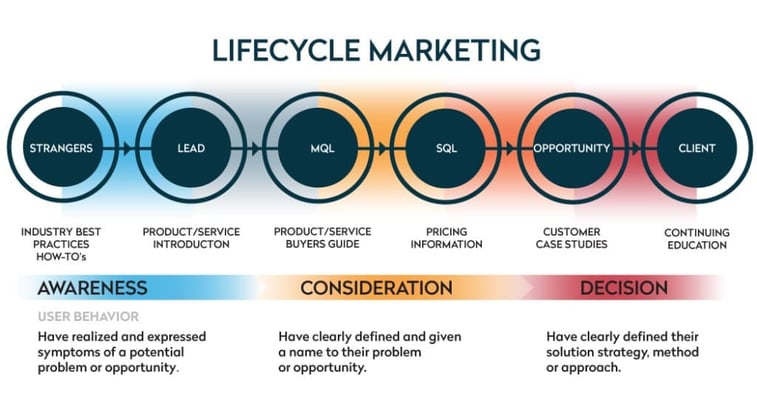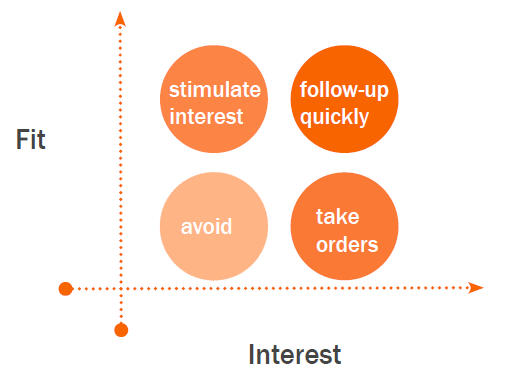Today, Inbound Marketing teams are often judged by how many MQLs (marketing-qualified leads, and SQLs (sales-qualified leads) they can generate each month. Jobs are won and lost over this ratio – so, MQLs have got to be important, right?
Right.
But what are they?
MQL stands for Marketing Qualified Lead. A lead is simply a prospective customer, created when either an individual or business shows interest and/or provides some form of contact information. Marketing leads are usually a byproduct of your marketing efforts.
Not all leads are created equal, however, and a Marketing Qualified Lead is a lead that the marketing department deems likely to eventually convert into a sale, and thereby qualifies for receipt of additional marketing materials and nurturing efforts, but isn’t yet ready to receive a sales call.
Other types of lead include SQLs (sales qualified leads) and opportunities.
Check out the following articles to learn more about leads:
- The Best Beginner's Guide to SaaS Lead Generation Today
- 6 Powerful Lead Generation Strategies for B2B Companies
- B2B lead generation guide: how to get more leads
Understanding the Lead Lifecycle
To better understand exactly what an MQL is, we need first to get to grips with the buyer’s journey and lead lifecycle.
The buyer’s journey essentially has three stages – the awareness stage, consideration stage and decision stage.
Prospects at the awareness stage realize that they have some form of a problem and begin researching various companies that might offer a solution. In the consideration stage, they are now more acutely aware of what their problem is, have identified sales and marketing teams as key players in providing a solution, and are pitting these companies, along with high-quality leads and prospective customers, against one another in their decision-making process.
In the decision stage, prospects have decided that they are going to make a purchase and have indeed chosen which company they are going to make that purchase from.

(Image source: garrisoneverest.com)
The buyer’s journey describes where the prospect is in terms of how close they are to making a purchase. The lead lifecycle, on the other hand, essentially describes an active process that is driven by a company’s marketing and sales teams.
In the customer segmentation journey, the sales process and the efforts of marketing teams are the driving forces. They collaborate closely to navigate customers through a wide array of stages. These well-defined stages provide invaluable insights for the sales process and marketing teams, enabling them to craft and execute strategies that attract high-quality leads and prospective customers effectively. This strategic approach, in the end, leads to the maximization of conversion rates.
As you can see from the image above, two different types of lead are present at each of the three stages of the buyer’s journey. Marketers work to identify lead types and target each type with carefully crafted content, always trying to further educate each lead and qualify them for the next stage in the lifecycle.
Here’s a list of short lead lifecycle definitions to give you a clearer idea of what we’re talking about:
- Strangers/Subscribers – A casual visitor or subscriber to your periodic content, such as your newsletter or blog.
- Lead – Someone who has provided a piece of contact information.
- Marketing Qualified Lead (MQL) – A lead that is deemed to be ready for direct marketing messages.
- Sales qualified lead (SQL) – A lead that is deemed ready to receive direct sales messages.
- Opportunity – Someone who is in receipt of sales correspondence, and is deemed ready to buy.
- Client – Someone who has made a purchase of your product or service.
Who Qualifies as an MQL?
Unfortunately, while the buyer's journey and buying cycle are relatively well-defined, the lead scoring process and utilization of marketing assets are less standardized. This means that the definitions of each stage in the lead lifecycle can vary significantly between companies, and as a result, the specific marketing assets and lead scoring methods employed will also differ in their intended purpose.
The important thing, however, is that you have a clear definition for each lifecycle stage at your company.
There are many complex marketing qualified lead actions. They are one of the hardest types of leads to define. They tend to fall into somewhat of a grey area – somewhere between being curious about what your company does and being in true consideration of the solution you offer..
What are the Indicators?
The concept of a Marketing Qualified Lead is inherently flexible. In order to define what an MQL is at your company, therefore, means identifying a number of key signals or behaviours that your lead will display in order to indicate that they qualify for additional marketing.
There will essentially be two types of signal – explicit signals and implicit signals. Explicit signals are the things that the lead told you about themselves when they gave their contact information, such as a demographic and firmographic information. Implicit signals, on the other hand, are the things that you will be able to infer from the actions the lead takes, such as downloading a specific piece of content.

(Image source: blog.hubspot.com)
Generally, in order for a lead to qualify as an MQL, they will need to display both explicit and implicit signals. Indeed, just because one of your leads in your CRM (customer relationship management) system happens to be in the right country, from the right industry and has the right job title, doesn’t mean that they are likely to buy from you.
However, if this same person starts to engage with your site and perhaps downloads an eBook or two, you can be pretty certain that you have an ideal lead in the consideration stage of your sales funnel and buyer's journey; they are therefore ready for additional marketing materials and nurturing efforts.
Conversely, if someone from the wrong country, wrong industry or with the wrong job title starts downloading content, you probably won’t want them to become an MQL. And so it’s important that you have all the specific MQL criteria – both explicit and implicit – precisely defined for your company.
This is because you should only be ploughing marketing resources into moving the right people along buyer’s journey, for indeed, the wrong people will remain stuck where they are no matter how much work you put into them.
In short, your lead needs to be a good fit for your business plus be displaying interest in what you have to offer in order to qualify as an MQL.
Over to You
Defining your MQLs is one of the most crucial aspects to your ongoing Inbound Marketing strategy. Your marketing team determines the success of your campaigns. Marketing Qualified Leads are essentially those leads who are a good-fit for your business and are often obtained organically without relying on your sales team. They align nicely with one of your Inbound Marketing personas, are displaying behaviours that indicate they are considering a purchase and are generally worth pursuing further.
Stick a big red flag into each of your Marketing Qualified Leads and provide them with the education and nurturing they need to move onto the next phase of the lead lifecycle – from there try to win that sale.
If you need help defining the lead lifecycle stages of the buyer’s journey at your company, or help with creating content to nurture your Marketing Qualified Leads, get in touch with the lead generation and nurturing experts at Incisive Edge today.









